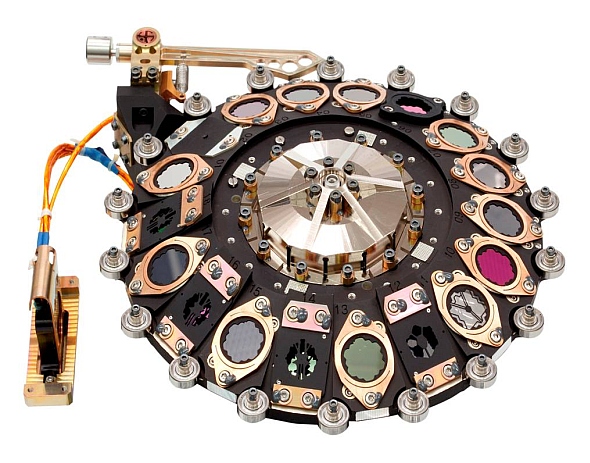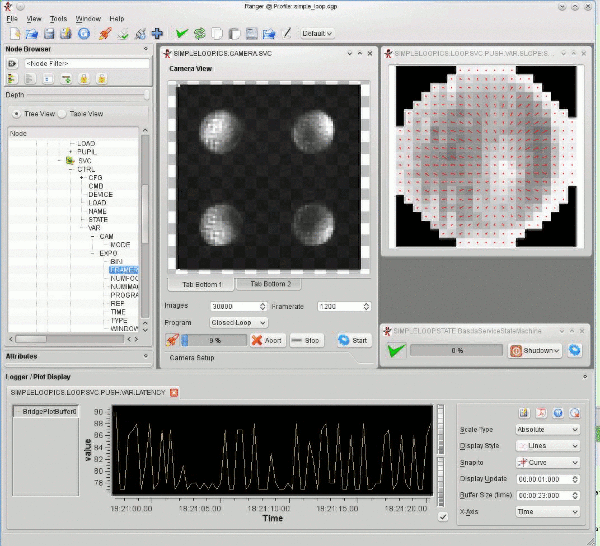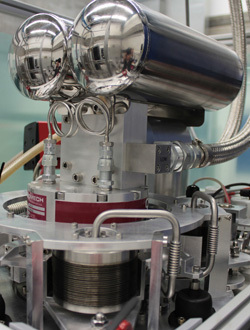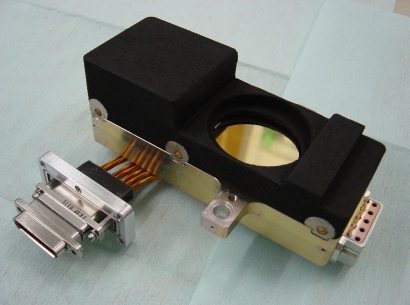| Version 268 (modified by , 7 years ago) (diff) |
|---|
The AstroTechTalk (ger) offers a place to discuss, for all interested colleagues and especially for the technical departments, the project leaders, the administration and the scientists as the ultimately users:
- status of instrumentation projects
- scientific tasks and features of the instruments in construction or planned
- new possible involvements
- technical innovations and developments
- technical problems and their solutions
- logistical problems and their solutions
- how to improve operation and observation
- project standards.
Time: Always Fridays 11:00 - 12:00
Location: Hörsaal
Outline:
- Announcements (news, visitors, etc.) (mainly in German)
- Talk of about 30 min about a selected topic (German or English, will be announced)
- Follow up discussion and questions (German or English, depending on the speaker)
Proposals for talks: Please send an email to "hofferbert -at- mpia.de" or "naranjo -at- mpia.de" - alternatively you might reach us by phone (06221-528209 or -290) or in person (room 211 or 018) at MPIA.
| Date | Speaker | Topic |
| 06.01.2017 | -- | Christmas break |
| 13.01.2017 | Philipp Dietrich (KIT) | Printed Micro-Optics and More 3D-micro-printing based on two-photon-absorption allows to manufacture free-form-structures of an arbitrary shape. The particular of this method is the creation of the desired structure at the very location of its later application. A subsequent positioning is not required, i.e. a perfect alignment is possible. Only in this way, 200nm silicon waveguides can be linked via 3d-printed free-form-waveguides („photonic-wirebonds“), which solves fundamental problems of integrated optics. Other options result from the capability to print free-form-lenses onto facets of optical components -like optical fibers-, whereby light is coupled much more efficiently into such fibers. But applications are not restricted to optics alone: Even the needle of a scanning-force-microscope is printable, such that each probe gets its optimal scanning head. Philipp Dietrich's talk will focus on optical devices, but will also highlight possible applications for astronomy. Presentation: German Slides: English Questions: German, English |
| 20.01.2017 | ||
| 27.01.2017 | Mathias Voss | Presentation of Construction Projects at MPIA (All-Institute-Meeting) Invitation and abstract will be distributed by the speaker himself. |
| 03.02.2017 | Domenico Bonaccini Calia (ESO) | Laser Guide Star Systems: ESO LGS Facilities and Technology R&D In this talk Domenico Bonaccini Calia will review the current LGS facilities on UT4 and present the resuts of the commissioning at the VLT of the Four Laser Guide Star Facility, which is part of the new Adaptive Optics Facility on the UT4 telescope of the VLT at Cerro Paranal. The main experimental results will be presented and compared with the requirements. In addition, a report on the activities in the area of the LGS systems R&D will be given. These are being done in collaboration with the AO community in the ESO member states, where currently two of in total four tasks have been completed. Domenico Bonaccini Calia will also report on the systematic measurement of the LGS return fluxes and on the LGS-AO loop results obtained with largely elongated LGS, similar to those foreseen for the EELT configuration. An outlook on the future, approved R&D will also be given. Presentation: English Slides: English Questions: German, English |
| 10.02.2017 | Dr. Felipe Guzmán (DLR) | Laser measurement science in gravitational physics Coherent light enables length measurements of exquisite sensitivity that lie at the core of fascinating observations in fundamental and quantum physics, astrophysics, geodesy and measurement science. In particular, observations from the Laser Interferometer Gravitational-Wave Observatory (LIGO) over the past year not only confirmed crucial gravitational physics effects, but have now also officially launched the era of Gravitational Wave Astronomy and Multi-Messenger observations. Similar laser-interferometric measurements have been demonstrated and are now flying on LISA Pathfinder, exceeding expectations and paving the way for a spaceborne Gravitational Wave Observatory that will allow us to survey the gravitational universe otherwise inaccessible to us from ground. Moreover, GRACE follow-on will continue to provide valuable information about fluctuations of the Earth’s gravitational field to the geophysical and climatology science community starting early 2018, whose observations will be greatly enhanced by interspacecraft laser gradiometric measurements. In the area of cavity optomechanics and novel compact and integrated photonics, the combination of low-loss devices and optomechanically coupled coherent light fields enables us to reach unprecedented measurement accuracies near the quantum sensing limit, which are of relevance in applications such as Atom Interferometers, Gravimeters, and particularly broadband inertial sensing. I will discuss the advances and implementation aspects of spaceborne laser measurements for gravitational physics and novel optomechanical inertial sensing technologies that have been the focus of my research over the last few years. Presentation: English Slides: English Questions: German, English |
| 17.02.2017 | ||
| 24.02.2017 | ||
| 03.03.2017 | ||
| 10.03.2017 | ||
| 17.03.2017 (11hrs, MPIA) | Wilma Trick | The Secret Life of the Galaxies During dark nights the Milky Way is observable as a wide band of stars and dust in the sky. The Milky Way is our home galaxy hosting also our solar system, but is only one of one hundred billion galaxies in the whole universe. There are spiral galaxies, huge elliptic galaxies, cloud-like dwarf galaxies, and galaxies dancing around each other before they finally merge into one. Where do all these galaxies come from? And why do they look as they look? In the past decades astro physicists have act as space detectives and have collected evidence for a better understanding of galaxy formation and evolution. One of the prime witnesses: The motion of stars. This led for instance to the discovery of super massive black holes and the mysterious dark matter of which we actually know only very little, apart from its omnipresent existence and its necessity for the formation of galaxies. Presentation: German Slides: German Questions: German, English |
| 24.03.2017 (11hrs, MPIA) | Robert Harris (ZAH, LSW) | Photonic Reformatting As astronomical telescopes grow in size the instruments behind them also grow. As the individual components become bigger, they become more difficult to manufacture, increasing the cost and making them more fragile (meaning unless you’ve got a particularly careful PhD student the cost of having spares also goes up). This has lead to many instruments using techniques such as image slicing to reduce the size of individual components and make the point spread function from the telescope manageable. Astrophotonics is a field that aims to combat the problems of size, cost and complexity. The idea is to take devices and technologies developed for the field of photonics and make use of them in astronomy. In this talk Robert Harris will describe his past, current and future work in a subfield of astrophotonics, photonic reformatting. This is akin to image slicing, but occurs within the fibre, meaning the devices are fully integrated. He will discuss both theoretical and practical aspects of his work and draw conclusions as to where he feels the field will go next. Presentation: English Slides: English Questions: German, English |
| 31.03.2017 (10hrs, HdA) | Damien Gratadour (Observatoire de Paris) | GreenFlash, an AO-Realtime-Computer Prototype for the EELT |
| 07.04.2017 | ||
| 14.04.2017 | -- | Good Friday |
| 21.04.2017 | -- | Easter Break |
| 28.04.2017 (TBC) (10hrs, HdA) | Thomas Bertram | Integration, Installation and Alignment of LINC-NIRVANA at the LBT |
| 05.05.2017 (10hrs, HdA) | Carolin Liefke | Remote Observing with HdA/MPIa's 50cm Telescope |
| 12.05.2017 (10hrs, HdA) | Thomas Mueller | Visualization in Astronomy |
| 19.05.2017 | -- | No room available |
| 26.05.2017 | -- | Bridging day after Ascension Day |
| 02.06.2017 | Justus Zorn (MPIK) | TBD |
| 09.06.2017 | -- | Pentecost holidays |
| 16.06.2017 | -- | Pentecost holidays |
| 23.06.2017 | ||
| 30.06.2017 | ||
| 07.07.2017 | -- | No room available |
| 14.07.2017 | -- | MPIA summer festival |
| 21.07.2017 (10hrs, HdA) | Roman Follert | Update on CRIRES+ (Last talk before the summer break) |
Preview:
15.12.2017 - Stefan Hippler: High-Contrast Imaging
Postview:
Presentations from 12.09. - 31.12.2014
Presentations from 01.01. - 31.07.2015
Presentations from 01.08. - 31.12.2015
Presentations from 01.01. - 31.07.2016
Attachments (11)
- instrum8_gr.jpg (82.6 KB) - added by 10 years ago.
- instrum4_gr.jpg (104.4 KB) - added by 10 years ago.
- pedv3_gr.jpg (213.9 KB) - added by 10 years ago.
- alfa3.5.gif (235.6 KB) - added by 10 years ago.
- CIAO.jpg (3.8 MB) - added by 8 years ago.
- linc_nirvana_labor.jpg (255.2 KB) - added by 8 years ago.
- MATISSE.jpg (43.1 KB) - added by 8 years ago.
- miri_fm_filterwheel.jpg (145.6 KB) - added by 8 years ago.
- PACS-Chopper.jpg (80.0 KB) - added by 8 years ago.
- simple_loop.gif (965.4 KB) - added by 8 years ago.
- teaser.jpg (13.5 KB) - added by 8 years ago.
Download all attachments as: .zip







